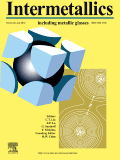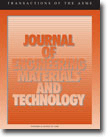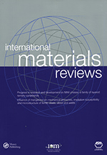
Uspekhi Fiziki Metallov-Progress in Physics of Metals
Scope & Guideline
Connecting Knowledge in Metal Research
Introduction
Aims and Scopes
- Materials Science and Metallurgy:
The journal emphasizes research in materials science, particularly regarding the physical and mechanical properties of metals and their alloys, including studies on microstructure, phase transformations, and mechanical behavior under various conditions. - Additive Manufacturing and Advanced Fabrication Techniques:
There is a significant focus on exploring and developing new additive manufacturing technologies, particularly for metals, which includes methodologies like 3D printing and laser melting, aimed at improving material properties and applications. - Corrosion and Surface Engineering:
Research addressing corrosion resistance and surface modification techniques is prevalent, focusing on enhancing the durability and performance of metal components in various environments. - Hydrogen and Environmental Effects on Metals:
The journal covers the impact of hydrogen on metals, including hydrogen embrittlement phenomena and methods for preventing such effects, signifying a critical area of interest in the field. - Nanostructured and Functional Materials:
There is a growing emphasis on nanostructured materials and their applications, particularly in the context of superconductivity, magnetic properties, and other advanced functional materials.
Trending and Emerging
- Additive Manufacturing and 3D Printing:
There is a clear trend towards increasing research on additive manufacturing techniques, particularly for metals, showcasing the industry's shift towards innovative fabrication methods that enhance material properties and applications. - Nanotechnology and Nanostructured Materials:
The growing interest in nanostructured materials is evident, with research focusing on their unique properties and potential applications in various high-tech fields, particularly in electronics and medicine. - Hydrogen Storage and Management:
Research themes addressing hydrogen storage materials and the effects of hydrogen on metals are gaining traction, emphasizing the importance of these topics in the context of sustainable energy solutions. - Advanced Surface Engineering Techniques:
Emerging studies on advanced surface engineering techniques, such as plasma treatments and coatings, reflect the industry's need for improved performance and longevity of metal components. - Multifunctional Materials and Alloys:
There is an increasing focus on developing multifunctional alloys, including shape-memory alloys and high-entropy alloys, which are becoming significant for various applications in modern engineering.
Declining or Waning
- Traditional Metallurgical Processes:
There appears to be a waning focus on conventional metallurgical processes and methods, with fewer papers addressing traditional techniques in favor of more innovative approaches such as additive manufacturing. - Basic Alloy Development:
Research solely focused on the development of basic alloys without innovative applications or advanced techniques is becoming less frequent, indicating a shift towards more application-oriented studies. - General Mechanical Properties of Metals:
While the mechanical properties of metals are still relevant, there is a decline in the publication of studies that do not incorporate advanced methodologies or novel applications, suggesting a preference for interdisciplinary approaches.
Similar Journals

Letters on Materials
Exploring the forefront of materials research and engineering.Letters on Materials, published by the Russian Academy of Sciences, Institute of Metals Superplasticity Problems, serves as a vital platform in the diverse field of materials science. Established in 2014 and running through 2024, this journal has carved a niche as a Q3 category publication, focusing on innovative research and developments in materials science and engineering. With its ISSN 2218-5046 and E-ISSN 2410-3535, it provides a unique opportunity for researchers and industry professionals to disseminate significant findings and theoretical advancements within the materials domain. While currently not categorized as open access, the journal maintains a global reach, promoting scientific dialogue and collaboration particularly within the Russian Federation and broader international audiences. Its placement within the 25th percentile in the Scopus rankings underscores its emerging significance, making it essential reading for anyone interested in cutting-edge materials research.

METALLURGIA ITALIANA
Illuminating the Path of Metallurgical ResearchMETALLURGIA ITALIANA, an esteemed journal published by the ASSOCIAZIONE ITALIANA METALLURGIA, specializes in the fields of condensed matter physics, mechanics of materials, and metals and alloys. With a history spanning from 1969 to 2024, this Italian journal has consistently contributed to the scholarly conversation surrounding metallurgical sciences and materials engineering. Despite its Q4 ranking in several categories, the journal provides a critical platform for emerging research and advancements in metallurgy, encouraging interdisciplinary dialogue among academics, professionals, and students. Readers can benefit from valuable insights into the latest developments and applications in the field, supported by the journal's commitment to fostering academic rigor and innovation. While access options currently do not include open access, METALLURGIA ITALIANA remains a cherished resource for those dedicated to exploring the nuances of material properties and applications.

Metals
Advancing metallurgical knowledge for a sustainable future.Metals is an esteemed open access journal published by MDPI, focusing on the diverse field of metallurgical science and its applications. Since its inception in 2011, the journal has provided a platform for the dissemination of high-quality research regarding the behavior, processing, and properties of metals and alloys. With an E-ISSN of 2075-4701, it has quickly established itself within the scientific community, achieving a remarkable Q1 ranking in the realm of Metals and Alloys and a Q2 rank in general Materials Science as of 2023. The journal is situated in Switzerland and is committed to the principles of open access, ensuring that findings are accessible to a broad audience without subscription barriers. With its notable impact factor and a strong emphasis on innovative research, Metals serves as an essential resource for researchers, professionals, and students seeking to advance their knowledge and understanding in the ever-evolving landscape of metallurgical studies.

Obrabotka Metallov-Metal Working and Material Science
Pioneering Research in Metals and AlloysObrabotka Metallov-Metal Working and Material Science is a pivotal journal published by Novosibirsk State Technical University, focusing on the dynamic fields of mechanical engineering, mechanics of materials, and the science of metals and alloys. With ISSN 1994-6309 and E-ISSN 2541-819X, the journal serves as a crucial platform for disseminating research from Russia and around the globe. Currently classified in the Q4 category for Mechanical Engineering and Mechanics of Materials, as well as Q3 for Metals and Alloys, it encompasses a wide range of studies from fundamental research to innovative applications. Despite its relatively recent inception in 2019, the journal has established itself with Scopus rankings that highlight its growing influence—Rank #122 out of 176 in Materials Science and Rank #510 out of 672 in Engineering. This journal aims to foster collaboration among researchers, professionals, and students by featuring original articles, reviews, and technical notes that address contemporary challenges in metal processing and material science. As it continues to evolve through 2024, Obrabotka Metallov remains dedicated to enhancing the understanding and application of materials science, making it a significant resource for those invested in the future of engineering and technology.

INTERMETALLICS
Connecting Chemistry and Engineering through IntermetallicsINTERMETALLICS, a prestigious journal published by ELSEVIER SCI LTD in the United Kingdom, has been a vital resource in the fields of Materials Science, Mechanical Engineering, and Chemistry since its inception in 1993. Renowned for its rigorous peer-review process and commitment to high-quality research, this journal enjoys an impressive position within the top quartile (Q1) rankings of its categories, signifying its influence and esteem in the academic community. With a particular emphasis on the study of intermetallic compounds and their applications, INTERMETALLICS attracts groundbreaking research and innovative contributions that push the boundaries of knowledge in metals and alloys, as well as mechanics of materials. Researchers looking for a platform to disseminate cutting-edge findings will find this journal an exemplary choice, further enhanced by its commendable Scopus rankings that illustrate its widespread recognition and relevance. Though it does not currently offer Open Access options, the journal remains committed to advancing the field through selective publication of impactful research, making it an essential reference for researchers, professionals, and students alike interested in the dynamic interplay between materials and engineering.

Materia-Rio de Janeiro
Exploring the intersection of materials and innovation.Materia-Rio de Janeiro is a distinguished open-access journal published by UNIV FED RIO DE JANEIRO, LAB HIDROGENIO, dedicated to advancing knowledge in the fields of Chemistry, Materials Science, and Physics. Since its inception in 2006, the journal has established a platform for the dissemination of innovative research, fostering collaboration among researchers globally. The journal's commitment to open access promotes the widespread availability of valuable scientific findings, making it an essential resource for academia and industry professionals alike. With a focus on diverse disciplines, Materia-Rio de Janeiro holds a Q4 classification in multiple categories for 2023, indicating its relevance in the expansive landscape of materials research. Operating from Rio de Janeiro, Brazil, this journal serves as a vital conduit for emerging scientific insights, hence delivering impactful contributions to the global research community.

Acta Metallurgica Slovaca
Connecting academia and industry through cutting-edge findings.Acta Metallurgica Slovaca is a distinguished open-access journal published by SCICELL SRO that has been pivotal in the field of Materials Science and Metallurgy since its inception. With a robust commitment to disseminating high-quality research, this journal covers a wide array of topics within the scope of metals and alloys. Now indexed in Scopus, it ranks 82nd out of 176 in its category, reflecting a growing influence within the scientific community. With a quartile ranking of Q3 as of 2023, Acta Metallurgica Slovaca serves as an essential platform for researchers and professionals seeking to share innovative findings and developments in metallurgical science. Open access since 2013, it ensures that research is accessible to all, fostering collaboration and engagement across academia and industry worldwide. With a converged publication timeline extending from 2009 to 2024, this journal continues to play a crucial role in advancing knowledge and addressing contemporary challenges in the metallurgy sector.

JOURNAL OF ENGINEERING MATERIALS AND TECHNOLOGY-TRANSACTIONS OF THE ASME
Elevating the discourse on materials technology and its impact.JOURNAL OF ENGINEERING MATERIALS AND TECHNOLOGY-TRANSACTIONS OF THE ASME is a premier journal published by the American Society of Mechanical Engineers (ASME), dedicated to advancing the field of engineering materials and technology. With an ISSN of 0094-4289 and E-ISSN 1528-8889, this journal has provided invaluable insights since its inception in 1973. Operating from its headquarters in New York, United States, it serves a global audience of researchers, professionals, and students alike. The journal is recognized for its rigorous peer-review process and its commitment to disseminating high-quality research, currently holding a Q3 quartile ranking across multiple categories including Condensed Matter Physics, Materials Science, Mechanical Engineering, and Mechanics of Materials. With a focus on exploring innovative materials and their applications, it aims to foster collaboration and discovery in the engineering community. Although it is not an open-access journal, it continues to play a vital role in shaping the future of engineering materials research up to 2024. Researchers and practitioners will find in this journal a significant platform to support the development and understanding of engineering materials, making contributions that resonate through academia and industry.

PHYSICS OF METALS AND METALLOGRAPHY
Decoding the Complexities of Metal Structure and BehaviorPhysics of Metals and Metallography, published by MAIK Nauka/Interperiodica/Springer, is a respected journal dedicated to the study of the physical properties of metals and their metallographic analysis, offering invaluable insights for researchers, professionals, and students in the fields of condensed matter physics and materials chemistry. With an ISSN of 0031-918X and an E-ISSN of 1555-6190, the journal has a rich history that spans from 1970 to 2024, reflecting a long-standing commitment to advancing knowledge in this vital area of materials science. Although it currently does not offer Open Access options, its strong placement in the academic landscape is underscored by its Q3 ranking in both Condensed Matter Physics and Materials Chemistry, according to 2023 metrics, and a Scopus ranking that places it within the competitive percentile of its fields. The journal is particularly important for those engaged in the cutting-edge research and technological applications of metals and alloys, making it an essential resource for anyone looking to deepen their understanding or contribute original findings to this dynamic discipline.

INTERNATIONAL MATERIALS REVIEWS
Unveiling Innovations in Metals and AlloysINTERNATIONAL MATERIALS REVIEWS, published by SAGE Publications Inc, is a leading journal dedicated to the comprehensive analysis of contemporary research in the fields of materials chemistry, mechanical engineering, mechanics of materials, and the study of metals and alloys. With an impressive impact factor and a Q1 ranking across multiple categories such as Materials Chemistry and Mechanical Engineering in 2023, it ranks amongst the top journals for innovative materials research. The journal has a long-standing history since its inception in 1987 and continues to serve as a crucial resource for academics and professionals alike. Although it is not open access, it is renowned for its rigorous peer-review process and its commitment to disseminating high-quality materials science research globally. Researchers, students, and industry professionals benefit greatly from the journal's insightful reviews, both for the advancement of theoretical knowledge and practical applications within the fast-evolving materials field.